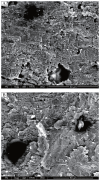Immediate and delayed micro-tensile bond strength of different luting resin cements to different regional dentin
- PMID: 23554806
- PMCID: PMC3602873
- DOI: 10.7555/JBR.27.20120028
Immediate and delayed micro-tensile bond strength of different luting resin cements to different regional dentin
Abstract
We sought to evaluate immediate and delayed micro-tensile bond strength of Panavia F2.0 and Multilink Sprint resin cement to superficial, deep and cervical dentin. Thirty-six freshly extracted non-carious human molars were sectioned in the mesiodistal direction to expose three different dentin regions including superficial dentin (1 mm below the dentine-enamel junction), deep dentin (1 mm above the highest pulp horn) and cervical dentin (0.5 mm above the cemento-enamel junction and 0.5 mm below the dentine-enamel junction). Resin cements were applied on dentin surfaces and composite blocks were luted under constant seating pressure. Each group was divided into three subgroups according to time intervals. Specimens were sectioned to obtain sticks of 1 mm(2) in diameter and subjected to microtensile bond strength testing at a cross head speed of 1 mm/min. Both resin cements showed higher micro-tensile bond strength to superficial dentin than that to deep or cervical dentin (P < 0.001). Micro-tensile bond strengths of Panavia F2.0 were higher than those of Multilink Sprint at different dentin regions (P < 0.001). Immediate micro-tensile bond strengths were higher than those of delayed micro-tensile bond strengths for both resin cements (P < 0.001). It was concluded that resin cements with different chemical formulations and applications yield significantly different micro-tensile bond strengths to different dentin regions.
Keywords: immediate and delayed micro-tensile bond strength; luting resin cements; regional dentin.
Conflict of interest statement
The authors reported no conflict of interest.
Figures



Similar articles
-
Microtensile bond strength and interfacial properties of self-etching and self-adhesive resin cements used to lute composite onlays under different seating forces.J Adhes Dent. 2006 Oct;8(5):327-35. J Adhes Dent. 2006. PMID: 17080881 Clinical Trial.
-
Micro-tensile bond strength of three luting resins to human regional dentin.Dent Mater. 2006 Jan;22(1):45-56. doi: 10.1016/j.dental.2005.02.009. Epub 2005 Jul 22. Dent Mater. 2006. PMID: 16040114
-
The influence of luting systems on the microtensile bond strength of dentin to indirect resin-based composite and ceramic restorations.Oper Dent. 2009 May-Jun;34(3):328-36. doi: 10.2341/08-101. Oper Dent. 2009. PMID: 19544823
-
Tensile bond strength of four resin luting agents bonded to bovine enamel and dentin.J Prosthet Dent. 2003 Jun;89(6):558-64. doi: 10.1016/s0022-3913(03)00177-x. J Prosthet Dent. 2003. PMID: 12815349
-
Microtensile bond strengths and scanning electron microscopic evaluation of self-adhesive and self-etch resin cements to intact and etched enamel.J Prosthet Dent. 2008 Sep;100(3):203-10. doi: 10.1016/S0022-3913(08)60179-1. J Prosthet Dent. 2008. PMID: 18762032
Cited by
-
Effect of Dentin Irrigants on Push-Out Bond Strength in Resin Cementation Protocols for Fiber Posts in Endodontically Treated Teeth: An In Vitro Study.Materials (Basel). 2024 Mar 21;17(6):1432. doi: 10.3390/ma17061432. Materials (Basel). 2024. PMID: 38541586 Free PMC article.
References
-
- Bouillaguet S, Duroux B, Ciucchi B, Sano H. Ability of adhesives systems to seal dentin surfaces: an in vitro study. J Adhes Dent. 2000;2:201–8. - PubMed
-
- Pashley DH, Ciucchi B, Sano H, Carvalho RM, Russell CM. Bond strength versus dentin structure: a modeling approach. Arch Oral Biol. 1995;40:1109–18. - PubMed
-
- De Munck J, Van Landuyt K, Peumans M, Poitevin A, Lambrechts P, Braem M, Van Meerbeek B. A critical review of the durability of adhesion to tooth tissue: methods and results. J Dent Res. 2005;84:118–32. - PubMed
-
- Loguercio AD, Uceda-Gomez N, Carrilho MR, Reis A. Influence of specimen size and regional variation on long-term resin-dentin bond strength. Dent Mater. 2005;21:224–31. - PubMed
-
- Reis A, Loguercio AD, Carvalho RM, Grande RHM. Durability of resin dentin interfaces: effects of surface moisture and adhesive solvent component. Dent Mater. 2004;20:669–76. - PubMed
LinkOut - more resources
Full Text Sources
Other Literature Sources
Miscellaneous

